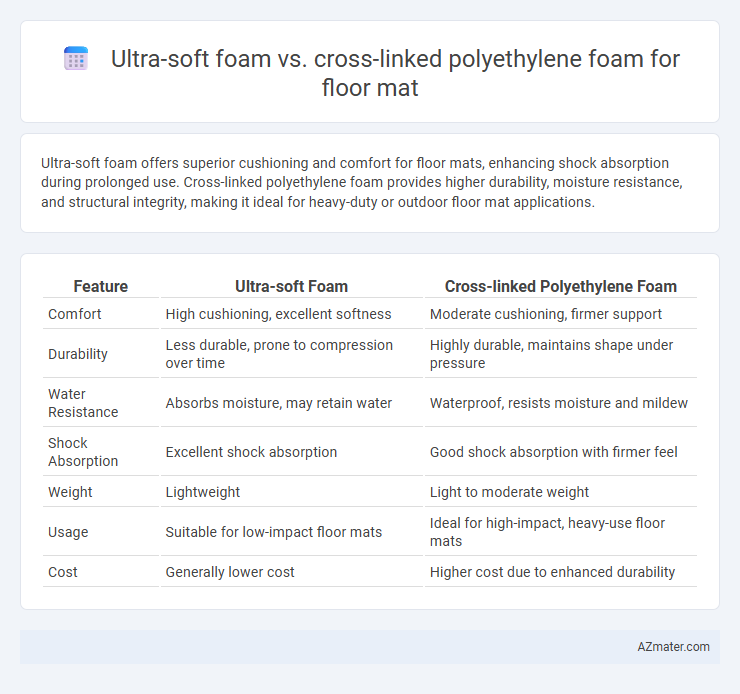Ultra-soft foam offers superior cushioning and comfort for floor mats, enhancing shock absorption during prolonged use. Cross-linked polyethylene foam provides higher durability, moisture resistance, and structural integrity, making it ideal for heavy-duty or outdoor floor mat applications.
Table of Comparison
| Feature | Ultra-soft Foam | Cross-linked Polyethylene Foam |
|---|---|---|
| Comfort | High cushioning, excellent softness | Moderate cushioning, firmer support |
| Durability | Less durable, prone to compression over time | Highly durable, maintains shape under pressure |
| Water Resistance | Absorbs moisture, may retain water | Waterproof, resists moisture and mildew |
| Shock Absorption | Excellent shock absorption | Good shock absorption with firmer feel |
| Weight | Lightweight | Light to moderate weight |
| Usage | Suitable for low-impact floor mats | Ideal for high-impact, heavy-use floor mats |
| Cost | Generally lower cost | Higher cost due to enhanced durability |
Introduction to Floor Mat Foam Materials
Ultra-soft foam and cross-linked polyethylene foam are two popular materials used for floor mats, each offering distinct benefits in terms of comfort and durability. Ultra-soft foam provides exceptional cushioning and pressure relief, making it ideal for areas requiring prolonged standing or impact absorption. Cross-linked polyethylene foam features a closed-cell structure that delivers superior resilience, water resistance, and long-lasting support in high-traffic floor mat applications.
What is Ultra-soft Foam?
Ultra-soft foam is a lightweight, flexible material with exceptional cushioning properties, often used in floor mats for superior comfort and shock absorption. Its open-cell structure enhances breathability and softness, making it ideal for prolonged standing or exercise activities. Compared to cross-linked polyethylene foam, ultra-soft foam offers a gentler surface with higher compressibility and quieter impact response.
What is Cross-linked Polyethylene (XLPE) Foam?
Cross-linked polyethylene (XLPE) foam is a durable, closed-cell foam known for its excellent cushioning, impact absorption, and thermal insulation properties, making it ideal for high-performance floor mats. Its cross-linking process enhances resistance to compression, moisture, and chemicals, providing long-lasting support and durability compared to ultra-soft foam. XLPE foam's lightweight and resilient structure offers superior protection and comfort in both residential and commercial flooring applications.
Comfort and Cushioning: Ultra-soft vs XLPE Foam
Ultra-soft foam offers superior comfort and cushioning with its low-density, highly flexible structure that absorbs impact effectively, making it ideal for prolonged standing or play areas. Cross-linked polyethylene (XLPE) foam provides moderate cushioning with greater firmness and durability, ensuring stable support and resistance to compression over time. For floor mats emphasizing comfort and softness, ultra-soft foam excels; for applications requiring balanced cushioning and structural integrity, XLPE foam is preferable.
Durability and Longevity Comparison
Ultra-soft foam floor mats offer excellent initial comfort but tend to compress and degrade faster under heavy use, reducing durability and lifespan. Cross-linked polyethylene foam mats exhibit superior resistance to compression and wear, maintaining structural integrity and cushioning over extended periods. This enhanced durability makes cross-linked polyethylene an optimal choice for long-term floor mat applications requiring consistent performance.
Safety Features and Child-friendliness
Ultra-soft foam floor mats provide excellent shock absorption and cushioning, reducing the risk of injuries from falls, making them ideal for child-friendly environments. Cross-linked polyethylene (XLPE) foam offers superior chemical resistance, durability, and hypoallergenic properties, ensuring a safe, non-toxic surface free from harmful VOCs for children. Both materials are designed to be non-slip and easy to clean, but XLPE foam's closed-cell structure enhances hygiene and prevents bacterial growth.
Water Resistance and Cleaning Ease
Cross-linked polyethylene foam offers superior water resistance due to its closed-cell structure, preventing water absorption and making it ideal for floor mats in damp or wet environments. Ultra-soft foam, while comfortable, tends to absorb water more readily, increasing the risk of mold and requiring more frequent cleaning. Cross-linked polyethylene foam's durable, non-porous surface allows for easier cleaning and maintenance compared to the more porous ultra-soft foam.
Environmental Impact and Sustainability
Ultra-soft foam used in floor mats, often made from polyurethane, tends to have a higher environmental footprint due to its petroleum-based origins and limited recyclability, leading to greater landfill waste and greenhouse gas emissions. Cross-linked polyethylene (XLPE) foam, characterized by its closed-cell structure, offers enhanced durability and is more resistant to moisture, which reduces the frequency of replacement and waste generation. Sustainable floor mat options favor XLPE foam for its longer lifespan and lower environmental impact, although recycling infrastructure for both materials remains limited, emphasizing the need for improved end-of-life management solutions.
Cost Analysis: Ultra-soft vs XLPE Foam Mats
Ultra-soft foam floor mats typically have a lower initial cost but may require more frequent replacement due to reduced durability compared to cross-linked polyethylene (XLPE) foam mats. XLPE foam offers higher resilience and longer lifespan, leading to lower long-term maintenance and replacement expenses despite a higher upfront price. Cost analysis favors XLPE foam mats for budget-conscious buyers seeking durability and extended value over time.
Choosing the Right Foam for Your Flooring Needs
Ultra-soft foam provides exceptional cushioning and comfort, ideal for areas requiring prolonged standing or sensitive joints, while cross-linked polyethylene foam offers superior durability, moisture resistance, and impact absorption suitable for high-traffic or industrial flooring. Selecting the right foam depends on usage frequency, environmental exposure, and weight support requirements, with ultra-soft foam excelling in comfort-focused applications and cross-linked polyethylene foam delivering long-term resilience and maintenance ease. Understanding these material properties ensures optimized floor mat performance aligned with specific functional and ergonomic needs.

Infographic: Ultra-soft foam vs Cross-linked polyethylene foam for Floor mat
 azmater.com
azmater.com